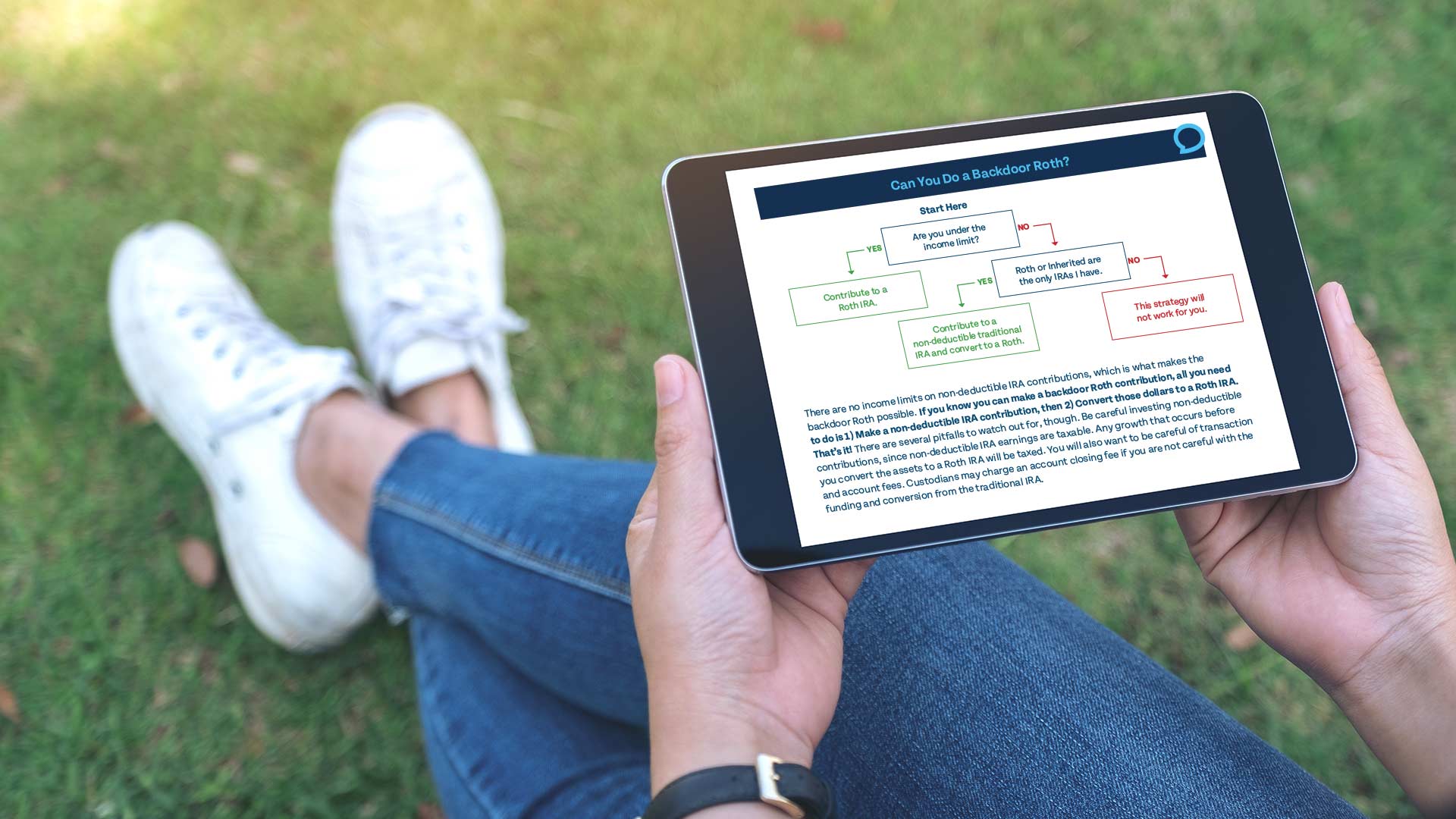
Change your life by
managing your money better.
Subscribe to our free weekly newsletter by entering your email address below.

Subscribe to our free weekly newsletter by entering your email address below.
Building wealth and saving big on taxes? That’s where Roth accounts shine. Let’s dive into how to leverage Roth strategies to maximize tax-free growth and accelerate your financial future.
Tax-free growth and distributions in retirement.
No Required Minimum Distributions (RMDs) — the government never forces withdrawals.
Flexible and accessible — not tied to a specific employer.
Wide investment options — more choices than employer plans.
Contribution limits:
As of 2025:
$7,000 annually for most single individuals.
Income phaseouts for Roth IRA contributions:
Phaseout starts at $150,000 modified adjusted gross income (MAGI).
Ineligible for direct contributions if MAGI exceeds $165,000.
Perfect for those whose income is too high to contribute directly.
How it works:
Contribute after-tax dollars to a Traditional IRA.
Convert that Traditional IRA to a Roth IRA.
If no investment gains are realized between steps, the conversion is tax-free.
Pros:
A simple process via platforms like Schwab, Vanguard, or Fidelity.
Converts non-deductible IRA dollars into tax-free Roth dollars.
Watch-outs:
If you have other pre-tax IRA assets, this triggers the pro-rata rule, which could create a large, unexpected tax bill.
Requires careful planning — not a DIY strategy if you’re unsure.
Best done only if you fully understand the tax implications or with professional guidance.
This is the “apex predator” of tax-free investing — but it’s more complex.
Key Numbers (2025):
$70,000: Total 401(k) contribution limit (IRS Section 415).
$23,500: Employee salary deferral (Traditional or Roth).
$46,500: Can include employer contributions and after-tax contributions.
How it works:
Max out your salary deferral ($23,500).
Let’s say your employer contributes $6,500.
Total so far: $30,000.
You now have $40,000 left in your limit.
Contribute that $40,000 as after-tax dollars.
Convert those after-tax contributions to a Roth 401(k) or Roth IRA — tax-free, if there’s no growth before conversion.
Example:
Salary deferral: $23,500
Employer match/profit-sharing: $6,500
After-tax contributions: $40,000
Total: $70,000 → All converted to Roth for tax-free growth.
Before doing a Mega Backdoor Roth:
Your 401(k) plan must allow:
After-tax contributions
In-service distributions or in-plan Roth conversions
Don’t do this at the expense of an employer match.
Not ideal for small business owners, who may have better options:
Profit-sharing plans
Cash balance plans
Other deductible retirement strategies
Again: DO NOT attempt this without full understanding or professional help.
Once Roth conversions are in place, your dollars can grow completely tax-free for years. This strategy lets your investments compound efficiently, building momentum so that your dollars work harder than you one day.
Subscribe on these platforms or wherever you listen to podcasts! Turn on notifications to keep up with our new content, including:
This Roth strategy can supercharge your wealth building. Guys, I am so excited to talk to you about this because who doesn’t love saving big on taxes? And we know that Roth dollars can be one of the best ways to do that.
Obviously, the main draw of a Roth IRA is that it offers tax-free growth and distributions in retirement. In addition, they aren’t subject to what are called required minimum distributions, meaning the government never forces you to take the money out of the account. They’re pretty flexible and accessible in that they’re not tied to a specific employer, and they offer a wide range of investment options.
Those Roth dollars are so powerful that the government literally limits how much you can contribute each year. As of 2025, that limit is $7,000 for most single individuals. Not only are Roth dollars so powerful that the government limits how much you can put in—they actually limit who is allowed to make direct Roth contributions based upon your income. One thing that’s not limited, though, is who can hit that like button, so show it some love!
All right, for single folks, if your modified adjusted gross income is above $150,000, you can make a partial Roth contribution. And if it goes over $165,000, you cannot make direct Roth contributions. Quick note though: we’re just going to use the numbers for single filers in this video. If you want a more complete rundown on the actual Roth phase-outs, you can check out our tax guide at moneyguide.com.
But what you can do are the strategies we’re about to cover right now. The main strategy you can use is what’s known affectionately as the backdoor Roth—or even maybe the mega backdoor Roth conversion—and each one is a little bit different, so we’re going to cover them separately.
The backdoor Roth is pretty straightforward. You contribute after-tax dollars to a traditional IRA and then you convert those dollars to a Roth IRA. This can be as simple as just clicking a few buttons inside of your Schwab, your Vanguard, or your Fidelity account. So long as those dollars didn’t have any gains, the process is often completely tax-free. And since those dollars are now in a Roth IRA, those dollars will grow tax-free. It’s pretty sweet.
That said, there are a few reasons you may want to steer clear of a backdoor Roth. The main reason you might not want to do the conversion is if you have other pre-tax IRA assets, even if they’re in a separate account. It’s because that will trigger something called the pro-rata rule. We won’t get into the nuances of how the whole thing works, but simply put, it could stick you with a large unexpected tax bill—and nobody wants that. So, you can’t have outside IRA balances.
The other reason is that this is a process that can take some planning in order to make sure you’re doing it correctly. That said, you should not do this if you’re not 100% sure you’re doing it correctly. If you think you could take advantage of this but you aren’t sure, consider contacting a professional like us.
But a regular backdoor Roth conversion is not the only way to take advantage of this opportunity. Now enter the mega backdoor Roth conversion. This is the apex predator of the investing world. This account strategy is a way to load yourself up with tons of tax-free money—but it is a little more complicated and a little more nuanced, and we need to go over some of the stuff around it first.
The big thing is that these accounts make heavy use of an employer-sponsored retirement plan, which as of 2025, have a total contribution limit according to Section 415 of the tax code of $70,000. Keep that number in mind because it’s important.
$23,500 of that limit is made up of your salary deferral—how much of your pay you can defer to the plan. So that’s just your normal traditional or Roth contribution that you make into your 401(k). The other $46,500 can be made up of the employer contribution, like an employer match or maybe a profit sharing, or your additional after-tax contributions.
And this is where the mega backdoor Roth comes in. You max out your salary deferral at $23,500. Then, after your employer puts their money in, you can contribute after-tax money all the way up to the Section 415 limit of $70,000. You can then convert all of those after-tax contributions to Roth, which is completely tax-free—so long as that money did not have any gains while it was sitting in the after-tax bucket.
Let’s walk through an example of how this would work with some round numbers for easy math. Let’s say that in one year, you’ve maxed out your salary deferral at $23,500 to your 401(k), and your employer, through matching and profit sharing, puts in another $6,500. That $6,500 plus your maxed-out salary deferral of $23,500 totals $30,000. That means that you still have $40,000 remaining in your bucket, and you can fill that bucket with after-tax dollars that can then be converted to Roth completely tax-free.
But again, there are some things to be cautious of. First and foremost, you need to make sure that your plan actually allows for after-tax contributions and either in-service distributions or in-service Roth conversions. Those last two are what actually allow the Roth piece to be possible.
And obviously, you need to make sure you’re not overextending your saving to take advantage of this. This strategy is not something you should do if it squeezes out your employer match. I mean, we want to make sure we get that free money. And you should be cautious of this strategy if you’re a small business owner, because there are a lot of other tax-efficient ways to use that money—like maximizing profit sharing, or doing a cash balance plan, or just taking advantage of other deductible retirement options.
And before you do this, again, make 100% certain you’re doing it correctly because you don’t want to do it wrong. But once you have these Roth conversions working for you, that tax-free growth can start building and accelerating your wealth—so that one day, your dollars can work even harder than you.


When Should I Claim Social Security?
Social Security can have big impacts on your retirement. But knowing when to draw Social Security can depend on a…
View Resource
The Money Guy Guide to Retirement
Here are 9 insights you don’t want to miss… Whether you are 30 years away from retirement or 5 years…
View Resource
Got An Old 401(k)?
Deciding what to do with your old 401(k) can be a pain. We're here to make it easy.
View Resource


How about more sense and more money?
Check for blindspots and shift into the financial fast-lane. Join a community of like minded Financial Mutants as we accelerate our wealth building process and have fun while doing it.




It's like finding some change in the couch cushions.
Watch or listen every week to learn and apply financial strategies to grow your wealth and live your best life.
Subscribe to our free weekly newsletter by entering your email address below.